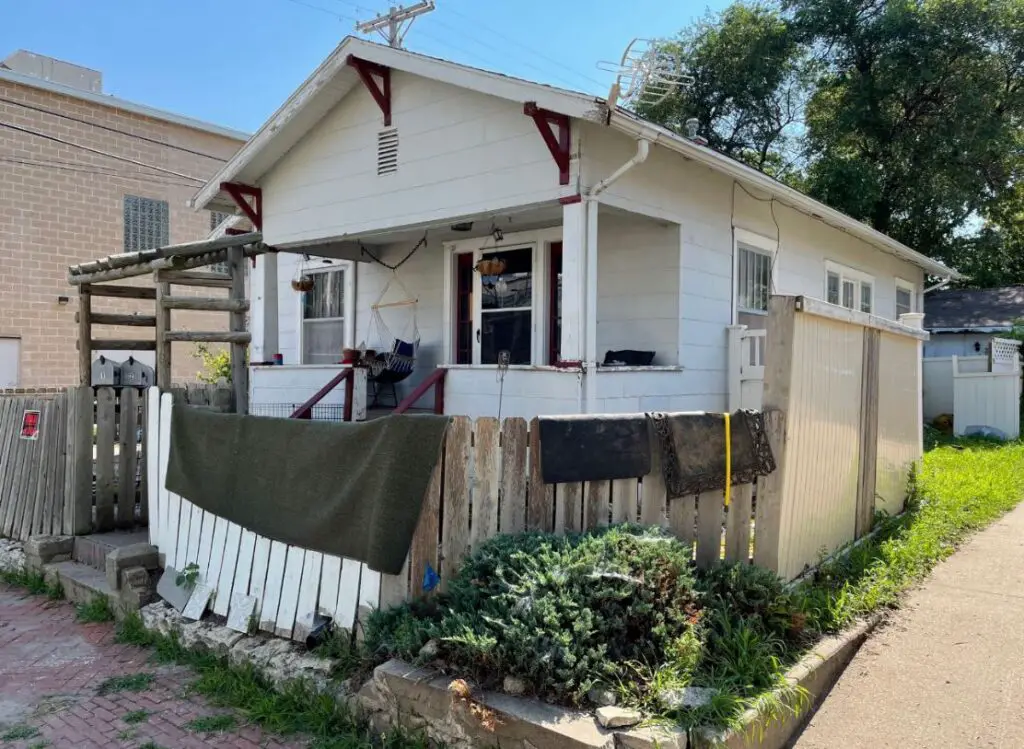
Courtesy of the City of Manhattan
An appeal by the Boys & Girls Club of Manhattan to demolish a home in the Pierre-Houston Street Historical District for green space has failed.
City Commissioners Tuesday unanimously voted to uphold the Historic Resources Board’s rejection of the project. The hearing was tabled at a mid-November meeting in which commissioners delayed their ruling while seeking additional info on renovation costs and the habitability of the Wurst Home, located at 212 South 5th Street.
“If we were the Historic Resources Board I would’ve easily said give them the application to demo it because of the big picture, but we don’t get the big picture decision we get the tiny picture decision,” says Commissioner Mark Hatesohl. “It says in your memo here when voting, each city commissioner should briefly summarize the competent, relevant evidence relied upon for voting on the findings — I ain’t got none.”
Read the prior story linked above for greater detail on the quasi-judicial process in which the commission was obliged to operate for the appeal.

Manhattan City Commissioners deliberate following the presentation of evidence (Courtesy of the City of Manhattan)
B&GC’s initial bid to get the demolition project approved was rejected in September for failing to meet numerous of the Secretary of the Interior’s standards for projects in recognized historical districts. While the property itself is not contributing to the historical district at this point, the standards still apply to projects relating to non-contributing structures in recognized districts.
A contractor working with the B&GC had provided estimates of about $155,000 in maintenance and repair work around the property, which commissioners asked to see itemized at this meeting. The itemized list added an additional $40,000 in cost necessary to address water entry into the basement, a project that they say would require sump pump installation and significant excavation of the building’s exterior perimeter.
“Our organization has been presented an opportunity to stick to our commitment to provide impactful opportunities and program activities in what could be a beautiful green space with garden and STEM based programming just feet away from our existing facility,” says Manhattan B&GC Executive Director Trent Jones.
Based on US Supreme Court rulings that city staff is in the best position to analyze relevant factors related to such a project and present that information to the municipal government, City Planner Ben Chmiel presented opposing evidence.
Chmiel also contradicted some of the estimates noted in the itemized list presented into evidence. He noted the reported figure of $155,000 was higher than the calculated sum of itemized costs, which rang in at $153,000. Numerous items, he says, were also not integral to the property’s continued use and existence as a residence.
Chmiel further noted that B&GC had reported figures derived from more specialized contractors in their cost estimates for repairs and maintenance work at the home.
“For instance, the hazardous material removal of the asbestos siding was originally quoted $15,000,” says Chmiel. “Associated Insulation, Inc. gave an estimate of $4,400, so that’s significantly less.”
Chmiel also says communication from the State Historic Preservation Office indicated only the front siding would need removal for the property to be eligible for historic tax credits. Estimated cost of that work was presented at $2,300, the completion of which would open the door for the credits. If received, they could cover up to 45 percent of remaining renovation costs.
Commissioners, by law, were required to rule on the project while considering if any feasible and prudent alternatives to demolition. In light of the evidence presented, Commissioner Usha Reddi voted against overriding the HRB.
“[Historic tax credits] make it more viable,” says Reddi. “If the owner wants to sell it to somebody else and they wanted to make any improvements it makes it more doable, more reasonable at that cost.”
Commissioners also sought additional information on the home’s habitability, seeking to assess whether it still has feasibility as a residence though the home is currently occupied by rental tenants. They had asked city staff and the B&GC to reach out to the property owner to see if they would call Manhattan Risk Assessment to schedule a home inspection to gather evidence on the topic.
The property owner did not attend either meeting and did not consent to an inspection of the property. This led Mayor Wynn Butler, who had previously leaned toward supporting demolition, to uphold the HRB’s ruling.
“It’s in terrible condition, but since the owner would not have it inspected by Risk Assessment it seems to me, then, that he must think it’s viable to keep as a rental property,” Butler says. “Therefore I agree with Commissioner Reddi, there’s no way I’m going to override the [HRB] because the evidence just isn’t there and the owner doesn’t seem to care.”
Commissioner Linda Morse concurred, saying she doesn’t believe all possible planning has taken place to minimize harm to the historic district.
“This property could be improved and restored,” says Morse. “I don’t think demolition is the only avenue to proceed.”
The post Manhattan upholds HRB ruling, will not authorize Wurst Home demolition appeared first on News Radio KMAN.

